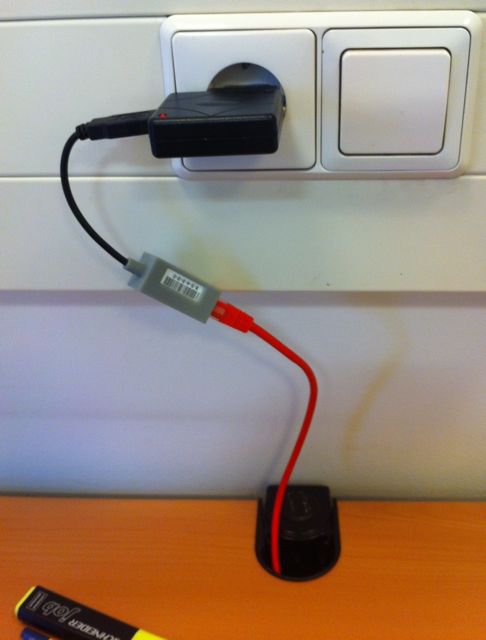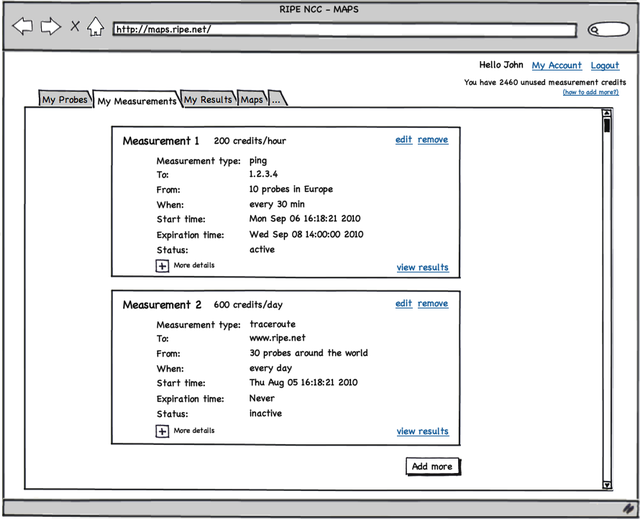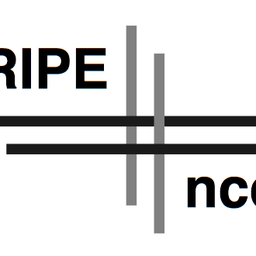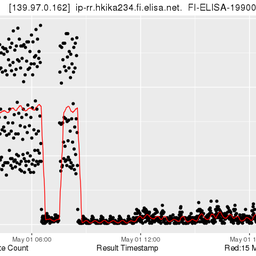Why YOU may want to host a small probe to help with large scale active Internet measurements.
Introduction
Situational awareness is very important in Internet operations, especially in abnormal situations when the business-as-usual tactics cease to work. Do you remember times when you wanted to know if anyone else was experiencing the problems you were facing? Wouldn't it be nice to have a dependable 'weather map' of your region or even the Internet as a whole?
On a more strategic level there is great interest for comparative data about Internet connectivity on the local, national and regional levels. Currently there is a focus on last-mile broadband speeds, because these are relatively easy to measure and understand. However as the last mile speeds increase, RTT (round trip time) and loss towards the real destinations will become more and more important to watch. To be meaningful, such measurements must be done continuously and not incidentally.

In previous articles I have described the need for more vantage points for active Internet measurements and the prototype of a small probe to achieve that. We have also reported some ad-hoc IPv4/IPv6 measurements using an early version of the probe.
In this article I will describe how we intend to convince you and thousands of others to help these measurements by hosting one of our small probes.
The photographs are of a pre-production unit. The production versions will look a little different and will have a nicer colour.
What You Can Do To Help
We will give a small, USB powered probe to you; it has an RJ-45 connector which speaks 10base-T and 100base-TX Ethernet. 
All the probe needs is a local address via DHCP and/or IPv6 RAs and connectivity to the Internet for ICMP(6), SSH, DNS, HTTP and a few other things. 

Obviously the probe will use some of your bandwidth to do the measurements. When registering the probe, you will be able to tell us how much bandwidth you would like to give to the probe; this will typically be a small amount compared to your upstream bandwidth.
So, all we ask you is to contribute a small amount of electricity and a small amount of bandwidth. Now why would you do that? And why would thousands of others do the same and become probe hosts, too?
Motivations
Of course you are an operational networker and you see the benefit of large scale measurements. That alone is enough motivation for you to help us. A little bit of altruism and a belief that the results of the measurements will be useful to you is enough to convince you. And we appreciate that attitude and your help ;-).
However it is unlikely that there are thousands like you so we have to do better. So, we looked at other motivations. Here is our current thinking:
Recognition
Even you may want to be recognised for your altruistic contribution. And maybe you participate as part of a whole group of enthusiastic people who may want to be recognised as a group. We will address that by measuring your individual contribution (and, very likely, that of your group as a whole) in terms of bandwidth and uptime. We will publish various rankings to recognise the contributors.
Privileges
We will make sure that hosts get privileged access to publications of measurement results. Hosts will also have a privileged way to participate in the development of our measurements.
Results
Hosts will have real-time access to the status of their probes and to a number of measurements taken by the probe. This means that by putting a probe on one of your networks you will get a 24/7 report of the connectivity of this network.
Your Own Measurements From Anywhere!
Now for the 'killer app': by hosting a probe you will be able to specify your own measurements using all other probes in the measurement network. So by hosting just one probe, you can get access to a very large number of vantage points from which to do your own measurements. For instance if you operate a web site and would like to monitor its availability from -say- Germany, you could specify a measurement from 10 probes in Germany every 10 minutes for a week and have hard figures available to you.
Earning and Using Credits
By now you think this is too good to be true: install just one probe and get unlimited access to all other probes. How is this going to work out if everyone starts measuring all they like? And you are right, this is not going to work. So we have to put the benefit you can get into proportion with your contribution: by hosting a probe you earn credits proportional to the time your probe is operational and to the bandwidth you offer. You can then spend those credits to perform your measurements.
Here is an example with totally arbitrary values: For every hour that your hosted probe is operational and can use 100 kbit/s of upstream bandwidth, you earn 100 points. Running a one-off ping measurement uses up -say- 10 points. Assuming these arbitrary values you could run a ping measurement from 10 vantage points to a single destination every hour in return for hosting the probe. If you want to do more measurements you have to donate more bandwidth, host an additional probe or get other hosts to donate their credits to you.
Here is a rough mock-up of how you will be able to define measurements:

Of course this is a conceptual view. The actual look of the pages may be very different. Since we want probes operated 24/7, we envisage bonuses for every 24h, week and month of continuous operation. We may also give you a sizeable welcome bonus once you have registered your probe, told us about its geographic location and connected it up. There may be other bonuses for answering surveys and the like. I am sure there will be lots of ideas to reward a little effort for the benefit of the community.
Community
Speaking of community: we will support collaboration by sharing credits and results among hosts. You will be able to join with others in order to perform a common set of measurements and share the results. We will also make it easy to publish reports about such results on RIPE Labs and other popular community channels.
Of course the RIPE NCC will also perform measurements on behalf of the RIPE community. We will use aggregated data from all the measurements done by the probes to develop new tools for the benefit of all. I will describe our detailed plans for this in a later article.
Stay tuned for the next article where I will explain how you can earn a serious amount of points and increase your community standing by sponsoring a number of probes.
If you are interested to participate in this measurements network, please contact us at labs at ripe dot net.





Comments 22
The comments section is closed for articles published more than a year ago. If you'd like to inform us of any issues, please contact us.
Anonymous •
Hi, how do I take part of this - I'm willing to help but your article lacks of any further information.<br /><br />Regards,<br />Tom
Anonymous •
Hi Tom,<br /><br />Thanks for your offer to participate! We will contact you with more information (and I will include contact information in the article above).<br /><br />Mirjam
Anonymous •
Hi Tom,<br /><br />great to hear you are enthousiastic about it already. A couple of articles down in this series we will include a web page where you can register to receive a probe. The prototype probes are in production; we expect them at the RIPE NCC in October. Those attending the Rome RIPE meeting will be able to pick one up there. Stay tuned.<br /><br />Daniel
Anonymous •
Yes, please sign me up for this.
Anonymous •
Henk, you will be able to sign up for this shortly. In fact we hope that most RIPE NCC staff will support our first wave of deployment. Stay tuned.
Anonymous •
Sounds nice. Do you have a privacy policy on what you're doing with the data you're collecting?
Anonymous •
This is in the works. Any suggestions? Any concerns?
Anonymous •
Good to hear. I think some statement on which information will be collected, what you're (not) doing with personal information,etc would be nice.
Anonymous •
OK. Here is the high level thinking:<br /><br />The probes are not passively collecting traffic; they are just doing active measurements. So there is almost no personal information collected. The personal information we will store has to do with hosts, sponsors and other participants, basically everyone who has an account. There is no rocket science here and we will use our standard pricvacy statement for this. See <a href="https://labs.ripe.net/about/privacy-statement" rel="nofollow">https://labs.ripe.net/about/privacy-statement</a><br /><br />Are we overlooking something?<br />
Anonymous •
Sounds fine. I assumed no personalized data would be collected, but it wasn't mentioned explicitly.
Anonymous •
By the way, I'd be happy to host one, either in one of our datacenters or at home.
Anonymous •
Hi Teun,<br /><br />Thanks for your interest. If you send your contact information to the RIPE Labs mailbox (listed above at the end of the article), we will inform you about the next steps.
Anonymous •
Hello,<br /><br />I hope that the RIPE keeps supporting the TTM Project and actively boosts the deployment of TTM boxes.<br />TTM boxes target rather on the backbone sites and I guess probes are a nice addon for the edge-part of networks. One should combine both projects and enrich the TTM project with the probe's data.<br /><br /><br />Gunther
Anonymous •
There are no plans to discontinue TTM. In fact we are planning to integrate our measurement activities more closely. One possible way to do that would be to regard TTM boxes as more powerful probes and integrate them into the framework we are building for the small probes. But we are planning to cross our bridges in the proper sequence. So we are first building the new framework. But we keep our other activities in mind.
Anonymous •
sounds exciting,<br /><br />cheers,
Anonymous •
I have send it as mail, but would like to share some questions to the world:<br /><br />I would like to know whether it would be possible to set-up some kind of collaboration in a community which is just in start-up.<br />Currently we are in the process of getting enough support for a civilian project in which we want to achieve our own fibre network in Breukelen, The Netherlands.<br /><br />Depending on what the probes are able to measure, it would be nice if we would be able to handout some (few hundred?) probes in order to make the community more aware of their current internet conditions. For RIPE it could show a boost in active probes, and it would be possible to test out network/ISP migrations when we are able to complete the fibre network.<br />
Anonymous •
Hi Robin,<br /><br />good questions. First the good news: Yes we have definite plans to enable specific communities share measurements. One way is for hosts to cooperate in a 'team', another is for a 'sponsor' to sponsor a number of probes and earn 'sponsor credits'. I will describe that in the next article of this series. Stay tuned.<br /><br />The bad news is that our first version of the probes is not really geared to measure what most people focus on: broadband speeds a la speedtest.net. There are two reasons for this: first of all the probe cannot easily take into account competing traffic on its connection as I described in <a href="https://labs.ripe.net/Members/dfk/a-small-probe-for-active-measurements" rel="nofollow">https://labs.ripe.net/[…]/a-small-probe-for-active-measurements</a> . Secondly the first version probe processor can only transmit and recieve about 10Mbit/s worth of IP packets.<br />We are interested in ping, traceroute and service measurements, hence we have not optimised our design for raw speed. We believe that raw speedtests to/from near targets are not all that is interesting in the long run. Also these are best done incidentally and under user control and others like <a href="http://www.speedtest.net/" rel="nofollow">http://www.speedtest.net/</a> and <a href="http://www.samknows.com/broadband/index.php" rel="nofollow">http://www.samknows.com/broadband/index.php</a> already provide those.<br /><br />If there is enough interest the next version of our probe may at least be faster. Our probe programming team wishes for that as well. ;-)<br /><br />I hope this answers some of the questions on your mind. Stay tuned for the next couple of articles that will explain the team, sponsor and community concepts.<br /><br />Daniel
Anonymous •
Hi Daniel,<br /><br />Actually I was not focusing my community plan on RAW speed, but would also more like to focus on availability, latency and such, as I would like to make people more aware of of their internet connection availability.<br /><br />Although RAW speed would be able to give more insight into the whole broadband world, especially as the European union is working on a plan that must guarantee minimal speeds, it could also benefit them.<br /><br />I sure hope I am able to get one (or more) probes to test out in the near future.<br /><br />Regards,<br /><br />Robin
Anonymous •
As an engineer i'm interested in the hardware that makes this happens. Can you please provide more information about the inner workings of the probe?<br />
Anonymous •
We're using Lantronix XPortPro modules. You can find a full description here: <a href="http://www.lantronix.com/device-networking/embedded-device-servers/xport-pro.html" rel="nofollow">http://www.lantronix.com/[…]/xport-pro.html</a><br />
Anonymous •
And Robert will post an artice about the architecture of the whole system in a couple of weeks. We will also write up the probe firmware design at some point this year, but not earlier than late November. I am happy to answer concrete questions though if they are burning you ;-).
Anonymous •
Thats really cool use of XPort modules :-)